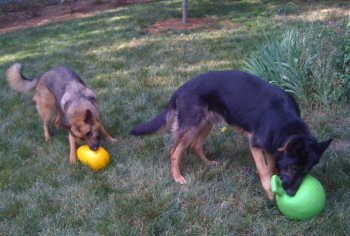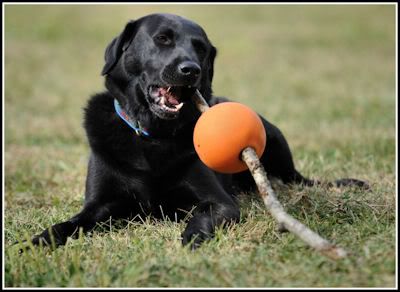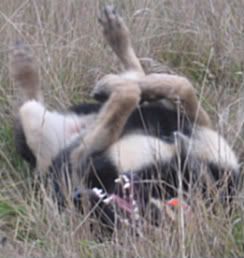 Avoidance advice needed from experienced handlers!
#281782 - 06/28/2010 02:32 AM Avoidance advice needed from experienced handlers!
#281782 - 06/28/2010 02:32 AM |
Webboard User
Reg: 12-01-2005
Posts: 70
Loc: Northern California
 Offline Offline |
|
I'm hoping some of you more experienced handlers can weigh in and help me with this situation. My bf's parents have a four year old female vizla (hungarian pointer, high prey drive) who needs some remedial training.
Some background:
What has put them over the edge to seek some help is that the dog is showing aggression, or at least dominance, toward our one year old niece. There are other less dangerous dominance/aggression behaviors going on with the residential adults as well. I am going to be coaching and helping them get this dog under control so she will hopefully not need to be put down. I definitely have big plans for her and ground work and changing the whole way they live with her and she will never be loose again with our niece.
My question is about avoidance training. In Ed's article about correction levels he lists things like getting on the furniture or into the garbage as things that merit a very strong correction that sends the dog into avoidance. In other articles and Q&A though he says that weak nerved dogs may be adversely affected by this or turn to handler aggression. I believe this dog is weak nerved and is mostly aggressive out of fear. I have only experience with my malinois who range from softer to harder in terms of required correction levels but none who had weak, nervy temperaments. Experienced handlers - what is your advice about this? Don't do avoidance training at all or just carefully? Something else?
Thank you in advance!
|
 Top Top
|
 Re: Avoidance advice needed from experienced handlers!
[Re: Melissa Snider ]
#281791 - 06/28/2010 08:54 AM Re: Avoidance advice needed from experienced handlers!
[Re: Melissa Snider ]
#281791 - 06/28/2010 08:54 AM |
Webboard User
  
Reg: 04-16-2010
Posts: 498
Loc: Southwestern USA
 Offline Offline |
|
Melissa, I'm going to let the others weigh in on the training issues, per se, but just offer a couple of ideas on management.
Those dogs were bred to RUN and run for miles at a time, so my number 1 reminder is "a tired dog is a good dog." I've been amazed at how many behavior problems can be reduced or eliminated altogether by a couple of good, long, rigorous workouts every day. We're talking biking, roading, whatever a few miles at a time. When anxiety is an issue, for humans or beasts, increasing physical activity almost always helps.
Second, I don't think the owners can go wrong with the "NILIF" philosophy (Nothing in life is free). It re-establishes pack rank, and just creates a predictable, safe, consistent environment for the dog - so important. Here's a link (for ACD rescue) that has ALOT of good stuff in it - some of which might apply to your situation.
http://www.nhcdrescuecolorado.com/training.htm
Good luck, and good for you for seeking information. This is certainly a good place to do so - there are some awfully knowledgeable folks around here.
A dog has alot of friends because he wags his tail instead of his mouth.
- Charlie Daniels |
 Top Top
|
 Re: Avoidance advice needed from experienced handlers!
[Re: Rob Abel ]
#281794 - 06/28/2010 09:27 AM Re: Avoidance advice needed from experienced handlers!
[Re: Rob Abel ]
#281794 - 06/28/2010 09:27 AM |
Webboard User

 
Reg: 04-09-2007
Posts: 185
Loc: Athens, Georgia
 Offline Offline |
|
Ditto on what Rob advised, especially concerning exercise.
Regarding corrections that send the dog into avoidance ... speaking as the owner of a (formerly) very nervous dog, don't do this around your niece. It *will* lead to very negative associations with the child, and that's *very* hard to fix later.
Control and containment is the way to go with a dog like this one. Don't allow for any interactions with the child, via use of the kennel and keeping the dog tethered at all times when out. Once the owners have established good pack structure, added a lot of exercise to the dog's routine and have developed a good relationship with the dog, then they can *maybe* begin possible dog/child interactions ... in the far, far future 

Synchronized Chomping |
 Top Top
|
 Re: Avoidance advice needed from experienced handl
[Re: Rob Abel ]
#281795 - 06/28/2010 09:31 AM Re: Avoidance advice needed from experienced handl
[Re: Rob Abel ]
#281795 - 06/28/2010 09:31 AM |
Webboard User
  
Reg: 01-16-2010
Posts: 1389
Loc:
 Offline Offline |
|
Those dogs were bred to RUN and run for miles at a time, so my number 1 reminder is "a tired dog is a good dog." I've been amazed at how many behavior problems can be reduced or eliminated altogether by a couple of good, long, rigorous workouts every day. We're talking biking, roading, whatever a few miles at a time. When anxiety is an issue, for humans or beasts, increasing physical activity almost always helps.
I don't think I qualify as an "experienced handler" but I would absolutely second this advice. When I was a teenager we had weimaraners. Except for being a different color and a little bigger, a weimaraner is essentially the same dog as a visla.
My father used to take them for two hour long off leash hikes 4 or 5 days a week. This was in addition to regular leash walks and lots of obedience training. Without that amount of exercise they would quickly become nervous, destructive dogs that were quick to get snappy and howled all day long.
Exercise and mental stimulation can make a night and day difference for these dogs. When they got what they needed they were fantastic, when they didn't it was a whole different story.
.
|
 Top Top
|
 Re: Avoidance advice needed from experienced handl
[Re: Lauren Jeffery ]
#281813 - 06/28/2010 11:26 AM Re: Avoidance advice needed from experienced handl
[Re: Lauren Jeffery ]
#281813 - 06/28/2010 11:26 AM |
Webboard User
  
Reg: 04-16-2010
Posts: 498
Loc: Southwestern USA
 Offline Offline |
|
Melissa, it's possible that it might help if folks know the context a little better of the problems you are describing.
How many dogs in the household?
What is dogs typical day like (how much time in crate, inside, outside)?
What training methods have the owners used primarily?
How often and for how long do to the owners work with the dog training/exercising/playing?
A dog has alot of friends because he wags his tail instead of his mouth.
- Charlie Daniels |
 Top Top
|
 Re: Avoidance advice needed from experienced handl
[Re: Rob Abel ]
#281824 - 06/28/2010 12:00 PM Re: Avoidance advice needed from experienced handl
[Re: Rob Abel ]
#281824 - 06/28/2010 12:00 PM |
Webboard User

   
Reg: 04-19-2009
Posts: 1797
Loc:
 Offline Offline |
|
Hi Melissa:
I am by no means a professional but I do have a very high drive, nervy, fear aggressive dog. His first 9 months were spent in an urban back yard with a six year old child as a playmate. Exercise and discipline, for him, was not on this single mother’s agenda. Well, as you can imagine, this ended very badly. I won’t go into detail but he was set for destruction when he came into my care.
He came to me a scared little boy in a 100 lb frame, with some very large teeth that lashed out at anything he didn’t understand – not to mention a total intolerance of any child. Just the sight of a small body and high pitched squeals had him hackling, trembling, tail between his legs and looking for an escape route. I can’t imagine what he went through, nor do I think it’s pertinent at this point.
No. 1 and I totally agree with the previous posts is exercise. Safe, fun, energy-draining exercise. Simply get that built-up, excess, anxiety-causing energy out of them – consistently, everyday.
The next is building trust. The last thing a fearful dog needs is a strong correction. The aggression can be so strong and intimidating (they are fighting for their life as they know it), most people confuse it with dominance and want to apply harsh corrections.
Building trust is a slow process that, for me, starts with allowing them to go weeks without anything to fear. They need to learn to live in a different state of mind - tons of exercise to remove the pent up anxiety and some simple, fun marker training, getting them used to the learning process and developing the structured foundation.
Once the relationship is established and they are looking to you for leadership the trust building exercises begin through desensitization. Slowly exposing them to their fears in safe places and at non-reactive distances.
It’s a long, slow, dusty road with lots of work cleaning out ghosts that we’re either inherent or have crept in through misguided interactions with humans. I’ve found that many people don’t have the patience, nor do they want to invest the time it takes to deal with the fear and opt to have their aggressive, biting dogs put down.
I commend you for taking this on. You may want to seek out a professional in your area and as Rob has indicated, perhaps provide a few more details of your situation. Each dog is very different.
|
 Top Top
|
 Re: Avoidance advice needed from experienced handl
[Re: CJ Barrett ]
#281830 - 06/28/2010 12:42 PM Re: Avoidance advice needed from experienced handl
[Re: CJ Barrett ]
#281830 - 06/28/2010 12:42 PM |
Webboard User
  
Reg: 01-25-2009
Posts: 1082
Loc: Columbus, Ohio
 Offline Offline |
|
CJ, I'm saving this post to refer to later. So many people forget this vital advice you've offered, "Building trust is a slow process that, for me, starts with allowing them to go weeks without anything to fear. They need to learn to live in a different state of mind - tons of exercise to remove the pent up anxiety and some simple, fun marker training, getting them used to the learning process and developing the structured foundation."

Ripley & his Precious
|
 Top Top
|
 Re: Avoidance advice needed from experienced handl
[Re: Meredith Hamilton ]
#281843 - 06/28/2010 03:21 PM Re: Avoidance advice needed from experienced handl
[Re: Meredith Hamilton ]
#281843 - 06/28/2010 03:21 PM |
Webboard User
Reg: 12-01-2005
Posts: 70
Loc: Northern California
 Offline Offline |
|
Thanks everyone for the quick, thoughtful replies and Rob for the link! I just want to say thanks especially to CJ, it sounds like you've done amazing things to save your dog.
I also want to say that this dog has never been traumatized in any way. She has lived with the family since 8 weeks and been the spoiled dependent dog-child in the empty nest. She lives in a house with 3 retired but active adults and is the only animal. She gets good exercise - at least two long walks a day with fetch in between and they also put her on the treadmill. They never had a drive-y dog before and didn't do the pack structure/ground work things that you and I take for granted. It was never a problem (for them at least) that this dog was confused about where she belongs in the pack until their granddaughter became mobile and now we're seeing some really not okay behaviors. So now they care and are willing to change their lifestyle with the dog.
My plan is to teach them how to do ground work/pack structure stuff and do only that for the next couple weeks and then start doing fun marker training obedience too. I think this dog will really thrive once her life is more structured and the owners can enjoy her more.
I was considering doing an avoidance level correction ONLY regarding the baby's possessions. Similar to what Ed describes in his article about introducing a new baby to a home with a dog. Teach the dog that everything in the house belongs to the humans, especially the child! So set her up with the baby's blanket, toys etc and do an avoidance level correction. I was hesitating on it because the dog is a little nervy. I really feel like she needs to think she's going to die if she approaches our niece or any child again - even though we won't be giving her the opportunity.
Any other opinions/advice on this?
Thanks all again!
|
 Top Top
|
 Re: Avoidance advice needed from experienced handl
[Re: Melissa Snider ]
#281846 - 06/28/2010 03:35 PM Re: Avoidance advice needed from experienced handl
[Re: Melissa Snider ]
#281846 - 06/28/2010 03:35 PM |
Webboard User
  
Reg: 08-30-2007
Posts: 3283
Loc:
 Offline Offline |
|
I don't like voidance training per se at all and use it only as a last resort for any problem.
For the moment I wouldn't allow child and dog together at all, even under supervison until some other (afore mentioned)foundations are in place.
If my isn't learning, I'm doing something wrong.
|
 Top Top
|
 Re: Avoidance advice needed from experienced handl
[Re: CJ Barrett ]
#281854 - 06/28/2010 04:15 PM Re: Avoidance advice needed from experienced handl
[Re: CJ Barrett ]
#281854 - 06/28/2010 04:15 PM |
Webboard User
  
Reg: 04-16-2010
Posts: 498
Loc: Southwestern USA
 Offline Offline |
|
Hi Melissa:
I am by no means a professional but I do have a very high drive, nervy, fear aggressive dog. His first 9 months were spent in an urban back yard with a six year old child as a playmate. Exercise and discipline, for him, was not on this single mother’s agenda. Well, as you can imagine, this ended very badly. I won’t go into detail but he was set for destruction when he came into my care.
He came to me a scared little boy in a 100 lb frame, with some very large teeth that lashed out at anything he didn’t understand – not to mention a total intolerance of any child. Just the sight of a small body and high pitched squeals had him hackling, trembling, tail between his legs and looking for an escape route. I can’t imagine what he went through, nor do I think it’s pertinent at this point.
No. 1 and I totally agree with the previous posts is exercise. Safe, fun, energy-draining exercise. Simply get that built-up, excess, anxiety-causing energy out of them – consistently, everyday.
The next is building trust. The last thing a fearful dog needs is a strong correction. The aggression can be so strong and intimidating (they are fighting for their life as they know it), most people confuse it with dominance and want to apply harsh corrections.
Building trust is a slow process that, for me, starts with allowing them to go weeks without anything to fear. They need to learn to live in a different state of mind - tons of exercise to remove the pent up anxiety and some simple, fun marker training, getting them used to the learning process and developing the structured foundation.
Once the relationship is established and they are looking to you for leadership the trust building exercises begin through desensitization. Slowly exposing them to their fears in safe places and at non-reactive distances.
It’s a long, slow, dusty road with lots of work cleaning out ghosts that we’re either inherent or have crept in through misguided interactions with humans. I’ve found that many people don’t have the patience, nor do they want to invest the time it takes to deal with the fear and opt to have their aggressive, biting dogs put down.
I commend you for taking this on. You may want to seek out a professional in your area and as Rob has indicated, perhaps provide a few more details of your situation. Each dog is very different.
Wow, there is an awful lot of wisdom in this post.
Bless you and Connie and all the other compassionate souls who have the ability and skills to do this difficult work, CJ.
A dog has alot of friends because he wags his tail instead of his mouth.
- Charlie Daniels |
 Top Top
|
When purchasing any product from Leerburg Enterprises, Inc. it is understood
that any and all products sold by Leerburg Enterprises, Inc. are sold in Dunn
County Wisconsin, USA. Any and all legal action taken against Leerburg Enterprises,
Inc. concerning the purchase or use of these products must take place in Dunn
County, Wisconsin. If customers do not agree with this policy they should not
purchase Leerburg Ent. Inc. products.
Dog Training is never without risk of injury. Do not use any of the products
sold by Leerburg Enterprises, Inc. without consulting a local professional.
The training methods shown in the Leerburg Ent. Inc. DVD’s are meant
to be used with a local instructor or trainer. Leerburg Enterprises, Inc. cannot
be held responsible for accidents or injuries to humans and/or animals.
Copyright 2010 Leerburg® Enterprises, Inc. All rights reserved. All photos and content on leerburg.com are part of a registered copyright owned by Leerburg Enterprise, Inc.
By accessing any information within Leerburg.com, you agree to abide by the
Leerburg.com Privacy Policy and Terms of Use.
 Previous Topic
Previous Topic Index
Index Next Topic
Next Topic











 Top
Top









